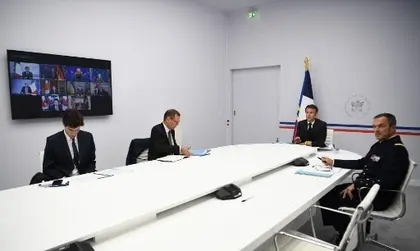In an emergency virtual meeting held on Oct. 11, leaders of the G7 group of nations reiterated their support for Ukraine in defending itself against Russia’s ongoing and brutal invasion.
At least 19 innocent civilians were killed in the Oct. 10 missile strikes in various cities across Ukraine, with dozens more injured.
JOIN US ON TELEGRAM
Follow our coverage of the war on the @Kyivpost_official.
Issuing a statement on the widely condemned attacks, Russian President Vladimir Putin said the strikes were carried out in retaliation for the Oct. 8 strike on a key bridge connecting occupied Crimea with mainland Russia. He claimed that military and infrastructure buildings were targeted in the strikes across Ukraine, despite it being confirmed that the sites hit were predominantly civilian.
The G7 emergency meeting concluded with the group issuing a statement saying: “We will continue to provide financial, humanitarian, military, diplomatic and legal support and will stand firmly with Ukraine for as long as it takes.”
In the virtual meeting, President Volodymyr Zelensky asked the G7 for further air defense systems to protect Kyiv and other parts of the country from future missile attacks, and requested that the group support an international mission on the Belarus-Ukraine border.
Zelensky’s request comes after pro-Putin Belarusian leader Alexander Lukashenko announced on Oct. 10 his unsubstantiated belief that Ukraine was planning an attack on Belarus (a claim that Zelensky has strongly denied), and that he had agreed to deploy forces with Russian soldiers at the border with Ukraine.

EU Transfers €1.5 Bln Raised From Russian Assets for Ukraine
Sharing the sentiments expressed by the G7, NATO Secretary General Jens Stoltenberg said NATO would support Ukraine for as long as needed. He condemned the recent sham referenda, along with Putin’s subsequent annexation of four regions of Ukraine.
Stoltenberg also suggested that NATO needed to produce more weapons for Ukraine, and that the alliance was currently in talks with member nations and defense companies.
The NATO chief added that the alliance was monitoring Russia’s nuclear forces following a series of threats by Russian officials and by Putin himself, and said that any attack on infrastructure critical to NATO would result in a “united and determined response.”
In an address at a fundraiser on Oct 6, U.S. President Joe Biden warned of the prospect of a nuclear “armageddon” if Putin’s war were to escalate further, however Stoltenberg confirmed that no change or movement in Russia’s nuclear arsenal had been observed by their intelligence.
In a statement released after the G7 emergency meeting, the White House said:
“We reassured President Zelensky that we are undeterred and steadfast in our commitment to providing the support Ukraine needs to uphold its sovereignty and territorial integrity.
The statement also warned of “severe consequences” should Putin decide to follow through with his threat of using nuclear weapons.
You can also highlight the text and press Ctrl + Enter






